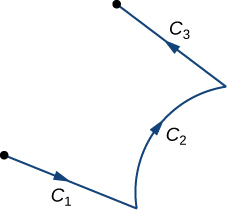| << Chapter < Page | Chapter >> Page > |
Find the value of integral where is the semicircle parameterized by and
Notice that this is the same problem as [link] , except the orientation of the curve has been traversed. In this example, the parameterization starts at and ends at By [link] ,
Notice that this is the negative of the answer in [link] . It makes sense that this answer is negative because the orientation of the curve goes against the “flow” of the vector field.
Let C be an oriented curve and let − C denote the same curve but with the orientation reversed. Then, the previous two examples illustrate the following fact:
That is, reversing the orientation of a curve changes the sign of a line integral.
Let be a vector field and let C be the curve with parameterization for Which is greater: or
Another standard notation for integral is In this notation, P , Q , and R are functions, and we think of d r as vector To justify this convention, recall that Therefore,
If then which implies that Therefore
Find the value of integral where C is the curve parameterized by
As with our previous examples, to compute this line integral we should perform a change of variables to write everything in terms of t . In this case, [link] allows us to make this change:
We have learned how to integrate smooth oriented curves. Now, suppose that C is an oriented curve that is not smooth, but can be written as the union of finitely many smooth curves. In this case, we say that C is a piecewise smooth curve . To be precise, curve C is piecewise smooth if C can be written as a union of n smooth curves such that the endpoint of is the starting point of ( [link] ). When curves satisfy the condition that the endpoint of is the starting point of we write their union as

The next theorem summarizes several key properties of vector line integrals.
Let F and G be continuous vector fields with domains that include the oriented smooth curve C . Then
Notice the similarities between these items and the properties of single-variable integrals. Properties i. and ii. say that line integrals are linear, which is true of single-variable integrals as well. Property iii. says that reversing the orientation of a curve changes the sign of the integral. If we think of the integral as computing the work done on a particle traveling along C , then this makes sense. If the particle moves backward rather than forward, then the value of the work done has the opposite sign. This is analogous to the equation Finally, if are intervals, then

Notification Switch
Would you like to follow the 'Calculus volume 3' conversation and receive update notifications?